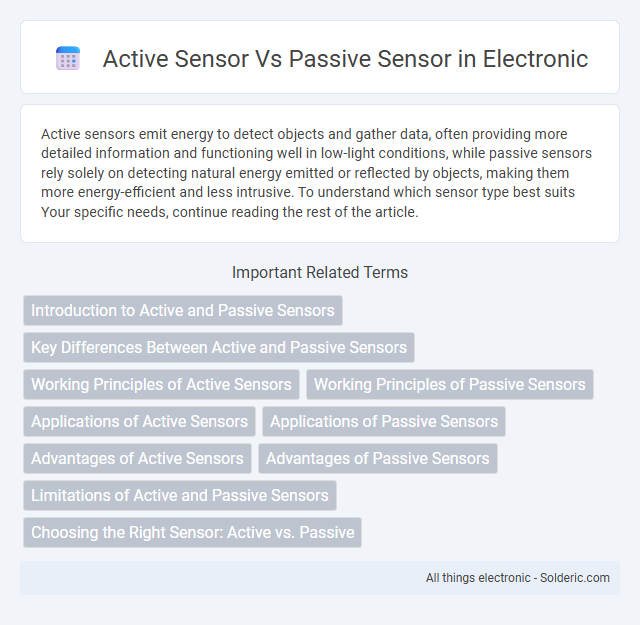Active sensors emit energy to detect objects and gather data, often providing more detailed information and functioning well in low-light conditions, while passive sensors rely solely on detecting natural energy emitted or reflected by objects, making them more energy-efficient and less intrusive. To understand which sensor type best suits Your specific needs, continue reading the rest of the article.
Comparison Table
| Feature | Active Sensor | Passive Sensor |
|---|---|---|
| Energy Source | Emits its own energy (e.g., radar, sonar) | Detects natural energy emitted or reflected by objects (e.g., camera, infrared) |
| Operation | Transmits signals and measures reflections | Measures ambient energy without emission |
| Application | Distance measurement, object detection | Imaging, environmental monitoring |
| Power Consumption | Higher due to active emission | Lower; relies on external energy sources |
| Environmental Dependence | Less affected by ambient light | Highly dependent on external conditions |
| Examples | Radar, Lidar, Ultrasonic sensors | Cameras, Thermographic sensors, Photodiodes |
Introduction to Active and Passive Sensors
Active sensors emit their own signals like light or radio waves and measure the reflection to detect objects, enabling precise distance and speed measurements. Passive sensors detect natural energy emitted or reflected by objects, such as thermal radiation, without emitting signals, making them less intrusive and energy-efficient. Understanding the differences between active and passive sensors helps you choose the right technology for applications like remote sensing, surveillance, or environmental monitoring.
Key Differences Between Active and Passive Sensors
Active sensors emit their own energy, typically in the form of light or radio waves, to detect objects and measure distances, enabling precise data collection regardless of ambient lighting conditions. Passive sensors rely on detecting natural energy emitted or reflected by objects, such as thermal radiation or sunlight, which limits their functionality in low-light or obscured environments. Your choice between active and passive sensors depends on the specific application requirements, including environmental conditions, power availability, and the desired accuracy.
Working Principles of Active Sensors
Active sensors emit energy, often in the form of electromagnetic waves, and measure the reflected signals to detect objects or changes in the environment. These sensors rely on their own energy source to probe the surroundings, enabling precise distance, speed, and movement measurements. Your choice of an active sensor can enhance detection accuracy in applications like radar, sonar, and lidar systems.
Working Principles of Passive Sensors
Passive sensors detect natural energy emitted or reflected by objects without emitting any signals themselves. These sensors rely on ambient sources such as thermal radiation, visible light, or sound waves to gather information about the environment. Your choice of a passive sensor ensures minimal interference and lower power consumption in applications like temperature monitoring, imaging, and environmental sensing.
Applications of Active Sensors
Active sensors emit energy to detect objects and measure their properties, making them ideal for applications such as radar systems, LiDAR for autonomous vehicles, and sonar in underwater navigation. These sensors play a crucial role in military surveillance, environmental monitoring, and industrial automation by providing precise distance and speed measurements. Your choice of an active sensor can enhance accuracy and reliability in complex environments where passive sensors may fall short.
Applications of Passive Sensors
Passive sensors are widely used in remote sensing applications such as satellite imaging, where they detect naturally emitted or reflected radiation from objects, including thermal infrared sensors for temperature mapping and multispectral scanners for vegetation analysis. In environmental monitoring, passive sensors measure sunlight reflectance to assess water quality and detect oil spills without disturbing the area. These sensors are integral to surveillance systems, astronomy, and medical imaging technologies where non-intrusive data collection is essential.
Advantages of Active Sensors
Active sensors emit their own energy to detect objects or measure distances, enabling accurate data collection regardless of ambient light or weather conditions. This capability allows for precise monitoring in various applications, including LiDAR systems for autonomous vehicles and radar for weather forecasting. Active sensors provide real-time, high-resolution data, improving detection range and reliability compared to passive sensors.
Advantages of Passive Sensors
Passive sensors offer advantages such as lower power consumption since they do not emit signals but rely on detecting natural energy like thermal radiation. They are less complex and typically more cost-effective than active sensors, making them ideal for long-term monitoring applications. Additionally, passive sensors minimize interference and improve stealth in sensitive environments due to their non-emissive detection methods.
Limitations of Active and Passive Sensors
Active sensors emit their own signals to detect objects but face limitations such as higher power consumption, increased complexity, and susceptibility to interference in cluttered environments. Passive sensors rely on detecting natural energy or signals, which restricts their functionality in low-light or obstructed conditions and limits their range and resolution. Your choice between active and passive sensors depends on the specific application demands, environmental conditions, and power availability.
Choosing the Right Sensor: Active vs. Passive
Choosing the right sensor depends on the application's requirements for energy consumption, detection range, and environmental conditions. Active sensors emit their own signal or energy, enabling detection in low-light or obstructed environments with high accuracy, while passive sensors rely on detecting natural energy or signals, making them more energy-efficient and suitable for ambient monitoring. Evaluating factors such as power availability, desired detection precision, and operational context ensures optimal sensor selection between active and passive types.
active sensor vs passive sensor Infographic

 solderic.com
solderic.com